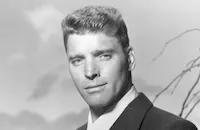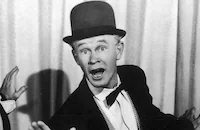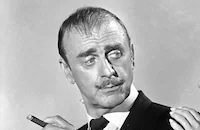The Hallelujah Trail

Brief Synopsis
Cast & Crew
John Sturges
Burt Lancaster
Lee Remick
Jim Hutton
Pamela Tiffin
Donald Pleasence
Film Details
Technical Specs

Synopsis
Denver is faced with a crisis before the winter of 1867 when it is discovered that there is only enough whiskey to last 10 days more. An emergency meeting is held, and Oracle Jones, who has visions when drunk, devises a plan to bring 40 wagonloads of whiskey to Denver from Julesburg before winter comes. Hobbs, a teetotaling editor, wires Cora Templeton Massingale, a temperance leader at Fort Russell, about the whiskey. Three Sioux Indians, Chief Walks-Stooped-Over, Five Barrels, and Elks-Runner, become aware of the plans of the wagon train, which is traveling under the direction of distiller Frank Wallingham. Col. Thadeus Gearhart, commander of "B" Company, U. S. Cavalry, is forced to escort the band of temperance women who are marching to intercept the whiskey train. "A" Company, under the command of Capt. Paul Slater, is to protect the whiskey train. Slater is in love with Gearhart's daughter Louise, one of the temperance ladies. The Sioux and a Denver citizens' militia under the direction of Clayton Howell are also heading for the whiskey train. Kevin O'Flaherty and his Irish teamsters stage a slow-down strike, thus leaving the train open to attack, which comes at dawn from the Indians. Suddenly during the attack, a large sandstorm comes, totally confusing everyone. No one is hurt during the battle, and the Indians agree not to disturb the train in exchange for some whiskey. The train, now traversing territory made dangerous by quicksand, is host to a temperance meeting arranged by the ladies for the Indians, who promptly kidnap the ladies and demand whiskey as a ransom. An elaborate exchange procedure is arranged. Oracle Jones persuades Wallingham to leave immediately for Denver. He arranges for a safe journey over the quicksand by marking a trail with his underwear, but Cora and the temperance ladies move the markers. Cora causes the horses to stampede, and the barrels containing hot champagne pop their corks, simulating gunshots. The Indians form a circle with the wagons while the cavalry rides around them. Wallingham and the train follow the marked trail and end up in the quicksand, the whiskey lost. Gearhart and Cora and Slater and Louise marry, and everyone goes home, except for Wallingham and Oracle, who sit beside the quicksand waiting for the whiskey to surface.

Director

John Sturges
Cast

Burt Lancaster

Lee Remick

Jim Hutton

Pamela Tiffin

Donald Pleasence

Brian Keith

Martin Landau
John Anderson
Tom Stern

Robert J. Wilke
Jerry Gatlin
Larry Duran
James Burk
Dub Taylor
John Mckee
Helen Kleeb
Noam Pitlik
Carl Pitti

Bill Williams
Marshall Reed
Caroll Adams
Ted Markland
Buff Brady
Bing Russell

Billy Benedict
Karla Most
Elaine Martone
Hope Summers
Carroll Henry

Whit Bissell
Val Avery

John Dehner
Crew
Hoyle Barrett
Elmer Bernstein
Marshall M. Borden
Paul Cameron
Richard Carruth
Thom Conroy
Depatie-freleng
Nate H. Edwards
John Franco
John Gay
Earl Gilbert
Angelo Graham
Bert Hallberg
Jack Harris
Edith Head
Wes Jeffries
Joe La Bella
Fred Lemoine
William Maldonado
Gilbert D. Marchant
Robert Martin
Robert Mcginnis
William Mendenhall
Cary Odell
Patrick J. Palmer
A. Paul Pollard
Clem Portman
Jack N. Reddish
Robert E. Relyea
Robert J. Schiffer
Thomas J. Schmidt
Ernie Sheldon
Fae Smith
W. C. Smith
Lynn Stalmaster
John M. Stephens
John Sturges
Bruce Surtees
Robert Surtees
Tim Vanick
David M. Walsh
Ferris Webster
Charles F. Wheeler
Allen K. Wood
Tim Zinnemann

Photo Collections
Film Details
Technical Specs

Articles
The Hallelujah Trail
The Hallelujah Trail was an ambitious project from the very start. The story follows two cavalrymen (Burt Lancaster and Jim Hutton) as they escort a wagonload of whiskey to Denver while enduring Indian attacks, belligerent drunks, and a crusading temperance league led by Lee Remick. To Sturges, it was a Western composed of pure situational comedy elements, a form of filmmaking that he had not tackled previously, plus the scope of the picture was truly daunting, even for Sturges. The production alone totaled nearly 300 cast members and a myriad of crew members behind the camera.
Shot on location in Gallup, New Mexico, The Hallelujah Trail definitely had its share of behind-the-scenes crises. In Against Type: The Biography of Burt Lancaster by Gary Fishgall, second unit director Tim Zimmerman recalled that Gallup in the early sixties was "a truck stop on the old Route 66. It was a very rough town...There were a lot of bars, and everybody went to all of them, and everybody got into trouble." Some of that trouble spilled over to the set and it was reported that Lancaster did not get along with two of his co-stars, Brian Keith and Lee Remick. Another problem, according to actor Martin Landau, "was bad weather continually. The day would usually start beautifully, and then the afternoon storms would come up." Worst of all, a stuntman named Bill Williams was crushed to death beneath the wheels of a wagon while performing a stunt.
On top of these production delays, which put the film six weeks behind schedule, Sturges took on the additional challenge of shooting in Ultra Panavision 70, an expensive widescreen process. In order to properly promote the film, Sturges released the picture through United Artists as a "road show" picture, a special exhibition showing (usually at a prestigious theater on a reserved-seat basis and at a higher admission price). This turned out to be a costly decision during a time in Hollywood when widescreen epics were quickly falling out of favor with American audiences. Furthermore, The Hallelujah Trail was not a traditional Western in any sense of the word and veered schizophrenically from broad physical comedy to epic action sequences. As expected the reviews were less than satisfactory and some critics simply hated the picture, citing the excessive length (165 minutes!) as a deterrent.
But The Hallelujah Trail was probably a victim of bad timing more than anything else for it followed in the wake of the much more successful Western comedy, Cat Ballou (1965). After all, how many Western spoofs do audiences want to see in one year? While The Hallelujah Trail might suffer in comparison to the former film, the New Mexico scenery looked breathtaking on the massive concave screens and the film's quirky sense of humor gave rise to other comedy-Western hybrids. Subsequent movies like There Was a Crooked Man...(1970), The Life and Times of Judge Roy Bean (1972), and Blazing Saddles(1974) were undoubtedly influenced by this blending of genre conventions that John Sturges introduced to contemporary audiences with The Hallelujah Trail.
Director: John Sturges
Producer: John Sturges, Robert E. Relyea
Screenplay: John Gay, based on the novel by Bill Gulick
Cinematography: Robert Surtees
Editor: Ferris Webster
Art Direction: Cary Odell
Music: Elmer Bernstein
Cast: Burt Lancaster (Col. Thaddeus Gearhart), Lee Remick (Cora Templeton Massingale), Jim Hutton (Capt. Paul Slater), Pamela Tiffin (Louise Gearhart), Donald Pleasence ("Oracle" Jones), Brian Keith (Frank Wallingham).
C-156m. Letterboxed.
By Scott McGee

The Hallelujah Trail
Quotes
Trivia
During location shooting in New Mexico the crew was confronted with the heaviest rainfalls in that region since 50 years. They washed away the tents as well as the set decoration.
Notes
Released in Cinerama.

Miscellaneous Notes
Released in United States 1965
Released in United States 1965














